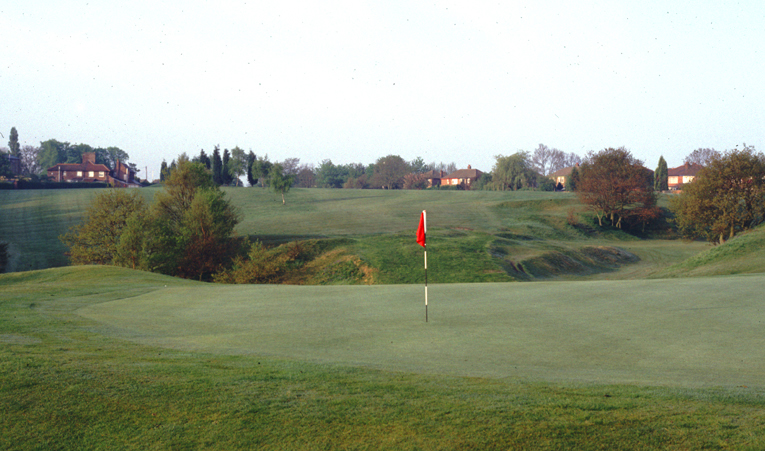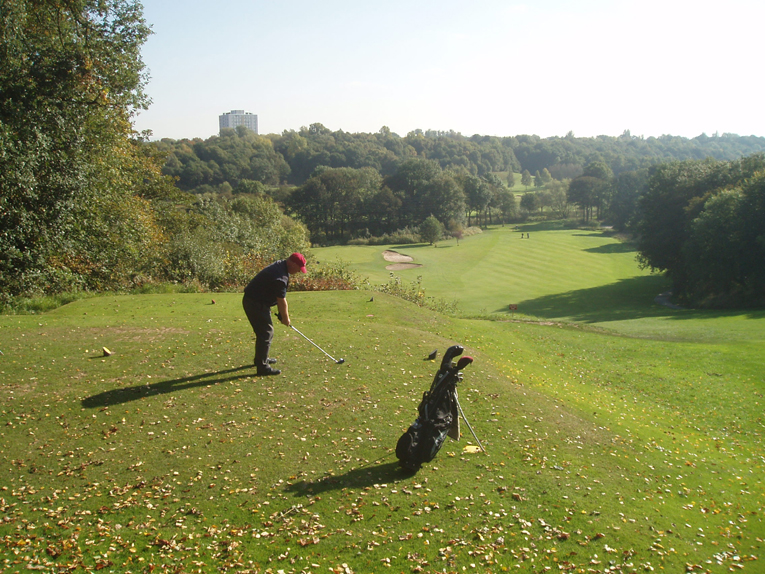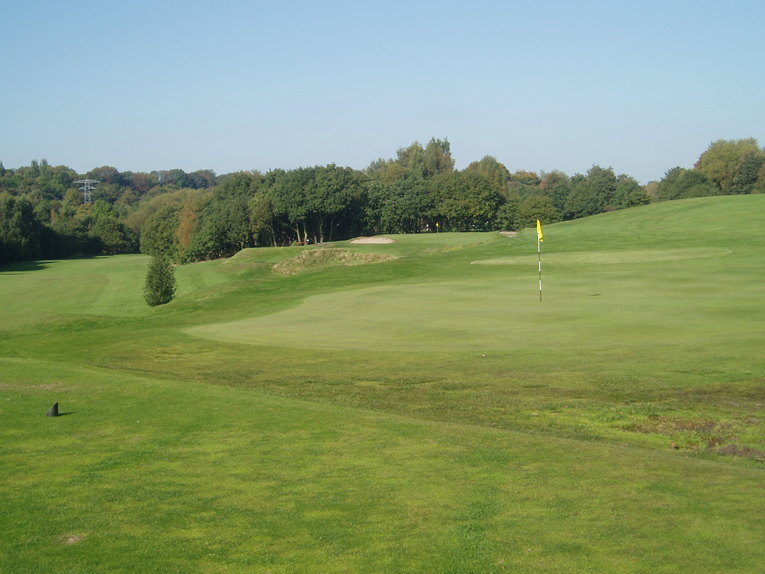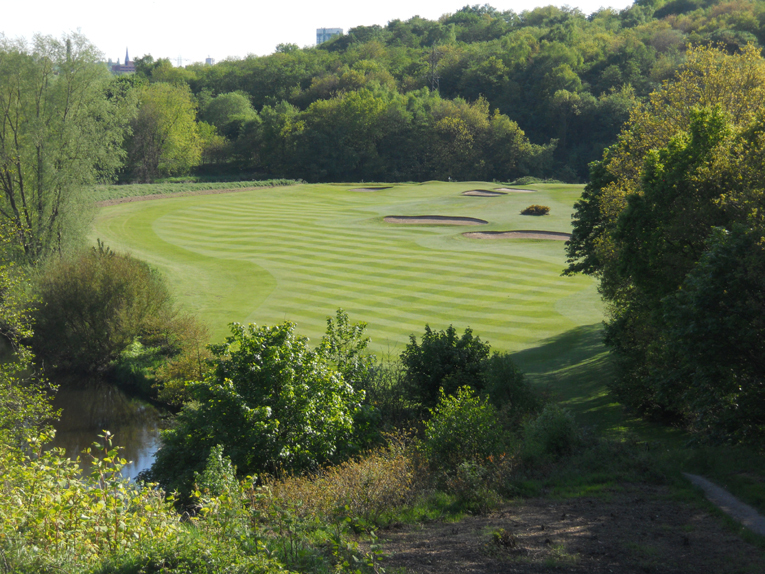Reddish Vale Golf Club
Cheshire, England, United Kingdom

Reddish Vale is an unheralded design gem, especially for a course built by Alister MacKenzie and that features some of the most memorable holes in the game. In the foreground is the sixth green reached from 240 yards away from a tee high on the hill. The fairway that leads up to the clubhouse is the eighteenth whose steep grade is unmatched in golf.
How artists begin their careers is as varied as the works they produce. Some like Mozart and Orson Wells commence with a bang and never look back while others including Monet and Raymond Chandler dabble here and there before finding their voice. After a round at Reddish Vale, Alister MacKenzie’s third eighteen hole course, one might conclude that MacKenzie belongs in the latter group. That would be inaccurate – he started with a bang!
MacKenzie’s first efforts were Alwoodley and Moortown, both located near Leeds 50 miles away. Admired far and wide, these courses possess the design attributes of a man who became a legend: great routings, strategy, well-integrated hazards, and imaginative green complexes. Alwoodley has especially stood the test of time and enjoys the same sense of expansiveness today that it did in MacKenzie’s time. Nobody mentions today’s Reddish Vale in the same breath with either Alwoodley or Moortown. And yet, to the author’s eye, it might well have been their peer.
When it opened in 1913 Reddish Vale possessed drama of the highest order. No other inland course in the United Kingdom offered such adventure, save for The Addington outside of London and perhaps Sunningdale Old. Listen to how Reddish Vale played then: its first five holes were high on the bluff where the clubhouse sits. Ravines and gullies abounded and threatened approach shots on this opening stretch. Ten mile long views were afforded over the English countryside, whose rolling landforms are always appropriately termed ‘lovely.’ To the left of the fourth and fifth fairways was a precipitous 150 foot drop with the rushing River Tame below. Unobstructed, the wind whipped around on these upland holes. Then, the mighty 240 yard sixth plunged downhill to a green beside the river. Holes seven and eight followed the river and led the golfer to the cunning ninth, which played steeply uphill to a modified Redan green.
Standing on the edge of a vale at the tenth tee, the golfer with his hickory clubs most assuredly appreciated the wondrous front nine journey he had just taken. He encountered burly two shotters that require shots over deep depressions to large rolling greens. Also, a quartet of superb one shotters, one of golf’s best in its time: the second over a gully to a green with a wicked back to front tilt, the dramatic fourth that runs along the precipice, the drop shot monster sixth, and a Redan which yard-for-yard is as tough as an English bulldog.
What did the back nine hold? More superlative golf with another string of holes rife with character that perhaps even outshines the front nine! Until at least WWII Reddish Vale was an eye-opening pleasure to the senses, a delight to play, and a challenge for the very best. No golfer could ask for more. That MacKenzie went on to become the game’s greatest architect should surprise no one – that’s how good his work was here.

The river is a feature rarely found in English golf and it brings a real sparkle to the proceedings at Reddish Vale. Its presence was once felt throughout the course to a far greater extent than it is today. The unblocked view from the sixteenth tee shows its true majesty and enduring appeal.
Rather than continue this fanciful stroll down memory lane, let’s examine today’s course. The most important thing is that all the holes noted above still exist! Yet, there are two primary reasons why it is no longer celebrated in the manner it deserves and once enjoyed.
First, there is the yardage. Unlike Alwoodley, the course is hemmed in by natural features that include a winding river and steep embankments. Its par is 69 and there isn’t room to extend its current 6,100 yards. It surely provided a cracking test for hickory players in 1915 who drove it 230 yards, but today one might sniff that it plays too short – and that would be wrong as we will see in the Holes to Note section below. Indeed, with its compact 120 acres of land, ravines, flowing water, and deft mix of long and short holes, the course reminds the author of Merion from her white tees of 6,105 yards (Merion’s back nine measures 2,865 yards by the way). In both cases, the golfer is left to wonder how so many quality shots could be fit into such modest dimensions.
Secondly, unchecked growth on the steep embankments and along the riverbanks has occurred for sake of stability. Unfortunately, the unintended consequence is that the dominant natural features are obscured, the very features upon which MacKenzie so carefully based the course. Today’s golfer plays the fourth and fifth holes devoid of the glorious, edge of the world vistas that once unfolded to his left. Today, spindly weed trees make the fifth a pedestrian hole, which is not how MacKenzie left it. Allow the golfer to sense the drama of playing high beside an embankment, discern that death awaits a pulled tee shot, let the winds sweep through, firm the turf and voilà, the fifth would play with the pizazz that MacKenzie intended. Down in the vale the river’s presence is sorely missed at the sixth through eighth and fifteenth holes. They remain fine holes but that extra spark and dimension that separates MacKenzie’s work from others is absent.
On the positive side, fine work has been done to improve two of MacKenzie’s holes, the fourteenth and sixteenth as we will see below. Additionally, the former Assistant Greenkeeper Nick Wilde was promoted to Head Greenkeeper in the fall of 2012. His work over the past eight months gives great hope that Reddish Vale’s glory days are on the return.
Holes To Note
(Please note: all photographs found within this course profile are courtesy of Mark Rowlinson, Duncan Cheslett, and Jim Eder).
First hole, 420 yards; The least interesting shot on the entire course occurs on the first tee. That puts Reddish Vale in good company with Scotland’s Turnberry and Sebonack on Long Island. Housing is visible and the fairway appears flat and devoid of interest. However, a two hundred yard walk ahead unveils something entirely different. The game is on!

As seen from behind, the downhill approach shot to the first is a thriller and must clear a 100 yard wide ravine.
Fourth hole, 170 yards; This was Henry Cotton’s favorite one shotter of the five and as he noted, a finer set ‘… could hardly be imagined.’ Reddish Vale originally opened with six one shot holes. Three of them are played in the first six holes, a sure sign that MacKenzie was a ‘lay of the land’ architect and believed in finding the best holes no matter how unconventional their sequencing might be. The back to back par 5s and par 3s at Cypress Point are another such example of following nature’s lead.

The 32 yard long fourth green is a mere ten paces wide in front before widening at the rear. Yet, back hole locations require one or perhaps two more clubs and are no bargain. Out of bounds is just to the left. Sadly, sweeping long vistas are precluded by the jungle on the left.
Sixth hole, 240 yards; Devotees of English golf will think of Nott’s famous downhill thirteenth whose heath and gorse clad hillsides paint a picture of exquisite charm. When created this hole matched-up because of the sight of the flowing river. Unfortunately, that grand panoramic view is now obscured. Hopefully, the inspired tree and brush clearing begun the past year will continue until the grandeur of the forty foot wide Tame is fully revealed. It’s too unique an asset to keep hidden. The Tree Preservation Order (TPO) is in place on certain of the older specimen trees along the river and that’s fine: we all enjoy stately, specimen trees. However, there is no excuse for keeping the spindly silver birches and bushy weeds.

The golfer prepares to flight his tee ball with a two hybrid. What a great shame that he can’t view the bending River Tame behind and to the left of the green because of the dense vegetation.
Eighth hole, 395 yards; The dirty secret of Reddish Vale is that the first nine measures less than 2,800 yards. How can that be, you scream; I have been hitting utility clubs and even a wood into some of the greens?! The answer lies in the fact that the first nine has four one shot holes. If two of them were par fours, the side would easily measure another 400 plus yards. Additionally, a hole like the eighth features a drive and approach that both stair step uphill, making the hole play at least twenty yards longer than the scorecard indicates.
Ninth hole, 135 yards; Pugnacious, this little brute can be a card wrecker and the side isn’t successful until the golfer gets past it unscathed. Out of bounds long and a false front create a tension in which only the most exact shot will find and hold the minuscule 2,300 square foot putting surface. Built into the corner of the property, this hole is a prime example of an architect getting the most out of every inch on a site.

Mongrel holes could have easily emerged from this portion of the property in the hands of a lesser architect. Instead, MacKenzie built this beauty which also made the tenth possible.

Standing on the tenth tee, the golfer looks across the hard to find ninth green and appreciates the seclusion afforded him by being down in the vale.
Reddish Vale Golf Club
Cheshire, England, United Kingdom
Tenth hole, 345 yards; By the early 1910s bold interior contours within putting surfaces of the sort found at Machrihanish and The Old Course had yet to be embraced on inland courses. There were a few exceptions such as MacKenzie’s fifteenth green at Alwoodley and his famed Gibraltar green at Moortown, but in general, interior green undulations were subdued. Therefore, the golfer is surprised – and delighted – to find this bold green punctuating the end of this short two shotter. Of great interest, member Duncan Cheslett found evidence that Mackenzie originally saw this hole as a par five with the green another hundred and ten yards on and to the right. Apparently, MacKenzie was torn and eventually decided that the merits of today’s fine natural green site outweighed the downside of a subsequent lengthy green to tee walk.

One of the best bunkers and greens on the course lend this short hole its playing qualities. Note the three foot rise in the middle of the green. The best-positioned fairway bunker on the course is 70 yards back in the middle of the fairway, perfectly crafted into a side slope.
Eleventh hole, 460 yards; MacKenzie famously had thirteen commandments for good golf design. It should come as no surprise to anyone familiar with his personality that MacKenzie would violate several of his own tenets here! The nines don’t return, the Home hole brazenly ignores his no ‘hill climbing’ rule, and his tenet calling for a minimum of blindness on approach shots gets pushed to the side, especially here and at the all-world thirteenth.

From the tee the yellow flag is barely visible beyond the brow of the hill to the right of the greenside bunker. In the fairway, the flag is not visible for most approach shots save for tee balls pounded down the left.
Twelfth hole, 190 yards; Variety, which is comprised of the range of clubs required and the diversity of challenges, is the critical factor when considering the merits of a course’s set of one shot holes. Reddish Vale scores extremely high with the latter. This hole, for instance, skirts along a distinctive twenty foot ridge the likes of which the golfer has rarely seen. This superlative one shotter kicks off a tremendous five hole stretch.

Tee balls pushed right leave a blind recovery fifteen to twenty feet below the putting surface. That severe trouble abounds along the right balances the fourth hole where the peril is to the left.

This view from behind nicely captures the left to right tilt near the green. The farther one shies away from the ridge, the more problematic the recovery shot.
Thirteenth hole, 455 yards; Proof of MacKenzie’s innate genius can be found in this one-off punchbowl green complex built beyond the brow of the hill. Inland courses rarely see such wild green complexes because nature tends to doll out broader landforms there than it does with sandy soil found by the sea. Such Dell complexes are found on the west coast of Ireland at Lahinch and Brancaster on England’s east coast but what a delight to find one near the Manchester International Airport! Finding two greens (e.g. here and the ninth) that measure less than a combined 4,500 square feet is highly unusual and is another reason why all golfers need to see Reddish Vale: you are guaranteed to find things that you’ve never encountered before.

Standing over one’s approach from 200 yards gives little indication of the true challenge ahead. Note the target on the tree.

What a green complex! Its tiny 2,100 square foot green plays bigger but trouble is all around despite there being no bunkers. This one would certainly make MacKenzie’s eclectic all time best eighteen holes.
Fourteenth hole, 340 yards; Today’s general surrounds of Reddish Vale are industrial and yet who would think that standing majestically high on the fourteenth tee looking at the fairway and river below? James Braid is given credit for pushing the fairway farther left and creating today’s bunkering pattern and angled green.

No benefit is gained from flirting with the two fairway bunkers. Better to place one’s tee ball in the left center of the fairway for the optimal approach into Braid’s angled green.
Fifteenth hole, 475 yards; This and the fourth epitomize Reddish Vale today. Both require good stout golf yet are now devoid of the drama that they once possessed in spades. In MacKenzie’s day the play on this dogleg left with hickory was to the base of the hill and then the golfer had to choose a line and fire his second shot on a diagonal over the river; the more courageous the carry, the shorter the pitch to the green. Today’s tall growth along the river bank negates those playing angles as well as the thrill of playing tight beside a steep river bank.
Sixteenth hole, 320 yards; MacKenzie built a long one shotter from today’s tee. In 1934, the club followed the sage advice of James Braid by remodeling the fourteenth and this hole where the green was moved some 150 yards to the right onto a peninsula. A short par four was born whose approach shot can be counted among the nerviest in the game. Its construction caused quite the controversy at the time but Henry Cotton was a big fan and wrote, “This hole of 320 yards is the best looking, most fair, and at the same time probably the most difficult hole I have ever played.” In the same 1940 Illustrated Sporting and Dramatic News article he added that any course with two such lovely holes as the fourteenth and sixteenth should ‘tell the world.’

A fascinating array of choices greets the golfer on the sixteenth tee. Player A could decide to play a five wood straight ahead and leave himself with a full wedge to the green. Player B might hit a driver on a line some sixty yards farther right in hopes of a short chip and run to the green.

Cotton called sixteen a drive and kick hole … but what a kick! The river is left, right and behind this long but narrow green. Far less vegetation on this peninsula would heighten the suspense of the approach and allow a remarkably situated green to be fully appreciated.

This view from behind the green highlights the river’s close proximity to the edge of the green. The author disagrees with the club policy of treating the water hazard as out of bounds.
Before moving on, it must be noted that a peculiarity of the course is the walk from Braid’s green to MacKenzie’s seventeenth tee – over 250 yards in length that retraces some of the sixteenth hole. Given that the second nine has just a single one shotter, is there a way to construct one between the today’s sixteenth green and the eighteenth tee which is some 180 yards away? The River Tame is between the sixteenth green and eighteenth tee and its presence could be utilized somehow. Regardless, rounds routinely at Reddish Vale are had in under three hours thanks to all the other short green to tee walks.
Eighteenth hole, 355 yards; Love it or hate it, the Home hole at Reddish Vale is one of the game’s most distinctive closers. The author chooses to love it. The almost incomprehensible ascent to the green from the fairway (a 150 yard shot climbs nearly 70 yards; a crazy ratio!) creates pressure to find the short grass off the tee because muscling a ball all the way up to the green is problematic. Despite the severe climb the hole manages plenty of playing charm thanks to its bowled out green complex. Big bounces from the left or right of the green occur and support MacKenzie’s belief in bold play (i.e. shots that get well up into the green can be rewarded but weak shots die into the hillside).

The view from the tee is daunting. Though the hole measures but 355 yards, a mid iron can easily be required for one’s second. As such it is the perfect final statement about how a course of this length can require so many taxing approach shots.

As seen from behind, MacKenzie’s imaginative green complex makes the hole into something far more interesting than an uphill slog. It also augured the inventive designs that would define the doctor from Yorkshire.
There you have it. It is hard to fathom finding such a diversity of shots and hazards on a course that measures 6,100 yards on 120 acres. No wonder that Mark Rowlinson, the keenest judge of courses in the United Kingdom, has long championed golf at Reddish Vale. There is no higher endorsement for a course than that and his words were the impetus for this course profile on GolfClubAtlas.com.
Near the start of his career MacKenzie worked magic here on a small parcel of land and went on to set the standard against which all other architects are measured. His future masterpieces like Royal Melbourne and Augusta National are characterized by a sense of scale. At one time Reddish Vale possessed that but, alas, no more. The growth that obscures the river robs the course of a dominant natural feature that MacKenzie highlighted when he routed the course. The thrill of the upland holes has been similarly muted because of unchecked vegetation. Sadly, Reddish Vale is no longer viewed among MacKenzie’s second tier of courses (which is of a higher caliber than 99% of all other architects) as it certainly was when he passed away in Santa Cruz in 1936.
Still, especially given that Manchester International Airport makes for an ideal gateway to the United Kingdom and Reddish Vale’s proximity to it, only a fool would pass up the opportunity to play this MacKenzie gem. Once touched by greatness, all the bones remain and the club is on the proper track to restore its luster.
The End




![Minchinhampton (Old) [2016]](https://golfclubatlas.com/wp-content/uploads/2018/09/Minchinhampton-500x383.jpg)
![St. Enodoc (Church) [2017]](https://golfclubatlas.com/wp-content/uploads/2017/11/St.-Enodoc-500x383.jpg)

![Sunningdale (Old) [2014]](https://golfclubatlas.com/wp-content/uploads/2017/11/Sunningdale-Old-Course-500x383.jpg)

![Sunningdale (New) [2009]](https://golfclubatlas.com/wp-content/uploads/2010/12/Sunningdale-New-Course-500x383.jpg)